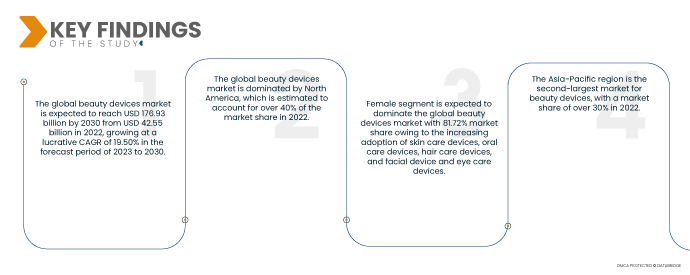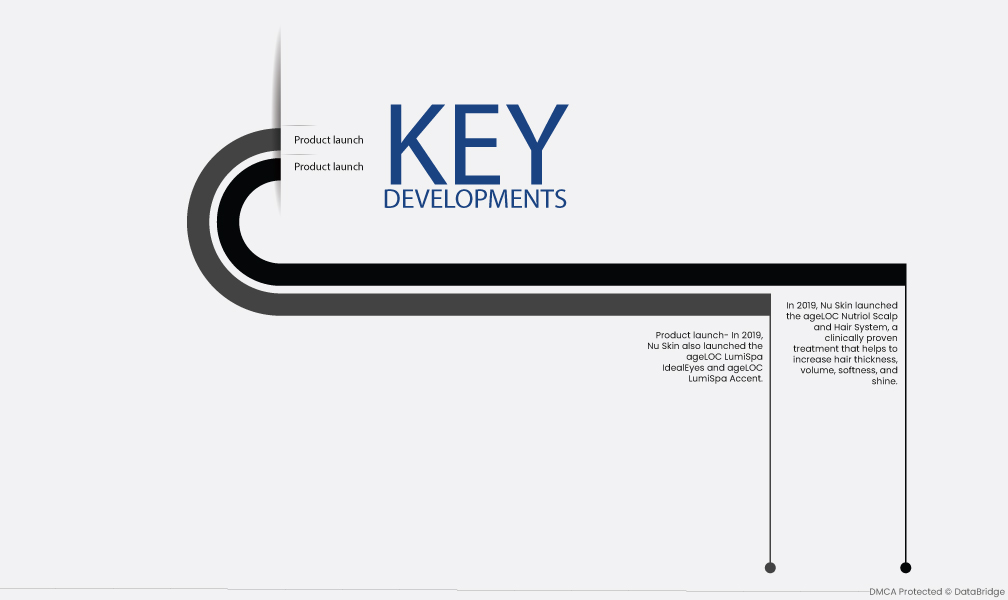Beauty devices are a growing industry, and for a good reason. They offer a convenient and affordable way to address many skin concerns. Laser treatments can be used to remove wrinkles or to reduce their appearance. Pigmentation is the uneven distribution of melanin in the skin. Melanin is the pigment that gives the skin its color. Chemical peels are often the most effective option for treating pigmentation but can also carry a greater risk of side effects. Laser treatments can be used to remove pigmentation or to reduce its appearance. Age spots are a type of pigmentation that is caused by sun exposure. They are often brown or black in color and can appear anywhere on the skin.
Access Full Report @ https://www.databridgemarketresearch.com/reports/global-beauty-devices-market
The Global Beauty Devices Market is expected to reach USD 176.93 billion by 2030 from USD 42.55 billion in 2022, growing at a lucrative CAGR of 19.50% in the forecast period of 2023 to 2030. Growing popularity of social media is driving the market growth. Social media has played a major role in raising awareness of beauty devices and their benefits. Changing demographics is yet another market growth driving factor. The global population is aging, and older adults are increasingly using beauty devices to maintain their appearance.
Growing demand for home beauty treatments is expected to drive the market's growth rate
People are increasingly looking for ways to save time and money on beauty treatments, and at-home beauty devices offer a convenient and affordable way. There have been significant advances in the technology used in beauty devices in recent years, making them more effective and user-friendly. For example, laser hair removal devices have become more powerful and efficient, and microdermabrasion devices have become more gentle and effective.
Report Scope and Market Segmentation
|
Report Metric
|
Details
|
|
Forecast Period
|
2023 to 2030
|
|
Base Year
|
2022
|
|
Historic Years
|
2021 (Customizable to 2015- 2020)
|
|
Quantitative Units
|
Revenue in USD Billion, Volumes in Units, Pricing in USD
|
|
Segments Covered
|
Type (Hair Care Devices, Facial Devices, Skin Care Devices, Oral Care Devices, and Eye Care Devices), Application (Hair, Facial, Skin, Oral, and Eye), Portability (Pocket-Sized/Handheld Device and Fixed), Mode of Operation (Electric and Battery Operated and Manual), Gender (Female and Male), End User (Commercial/Professional and Domestic/Personalized/ Homecare), Distribution Channel (Direct Sales, Retail, and Online |
|
Countries Covered
|
U.S., Canada and Mexico in North America, Germany, France, U.K., Netherlands, Switzerland, Belgium, Russia, Italy, Spain, Turkey, Rest of Europe in Europe, China, Japan, India, South Korea, Singapore, Malaysia, Australia, Thailand, Indonesia, Philippines, Rest of Asia-Pacific (APAC) in the Asia-Pacific (APAC), Saudi Arabia, U.A.E, South Africa, Egypt, Israel, Rest of Middle East and Africa (MEA) as a part of Middle East and Africa (MEA), Brazil, Argentina and Rest of South America as part of South America
|
|
Market Players Covered
|
Nu Skin (U.S.), CANDELA CORPORATION (U.S.), Silkn (U.S.), TRIA BEAUTY (U.S.), Curallux LLC. (U.S.), Termosalud (Spain), FOREO (Sweden), Tech4Beauty (Germany), Koninklijke Philips N.V. (Netherlands), Conair Corporation (U.S.), Lumenis (Israel), Cynosure (U.S.), Sciton, Inc. (U.S.), Fotona (Slovenia), Procter & Gamble (U.S.), Colgate-Palmolive Company (U.S.), LUTRONIC (South Korea), STRATA Skin Sciences (U.S.), NuFACE (U.S.), Spectrum Brands, Inc. (U.S.), Cutera (U.S.), Merz North America, Inc. (U.S.), El.En. S.p.A. (Italy), YA-MAN LTD. (Japan), Panasonic Corporation (Japan), Alma Lasers (Israel), Bausch Health Companies Inc. (Canada)
|
|
Data Points Covered in the Report
|
In addition to the market insights such as market value, growth rate, market segments, geographical coverage, market players, and market scenario, the market report curated by the Data Bridge Market Research team includes in-depth expert analysis, patient epidemiology, pipeline analysis, pricing analysis, and regulatory framework
|
Segment Analysis:
The beauty devices market is segmented on the basis of type application, portability, gender, end user and distribution channel.
- On the basis of type, global beauty devices market is segmented into hair care devices, facial devices, skin care devices, oral care devices and eye care devices.
Hair care devices segment of type segment is anticipated to dominate the beauty devices market
Hair care devices segment is expected to dominate the global beauty devices market with 36.22% market share owing to the rising adoption of hair care devices with increasing hygiene awareness and growing hair related problems. Furthermore, rapid upsurge in disposable income with innovation in technological in hair care devices propels the growth of the type segment.
- On the basis of application, global beauty devices market is segmented into hair, facial, skin, oral and eye.
Hair segment is projected to hold the largest share of application segment in the beauty devices market
Hair segment is expected to dominate the global beauty devices market with 36.22% market share owing to growing demand of hair care devices such as hair growth devices, hair removal devices, smart devices among others for the treatment of hair growth & care, hair removal and others. Furthermore, hair care devices are likely to be the highest growing segment in the global beauty devices market because consumers are progressively using hair removal devices due to changing lifestyles and hygiene in both developed and developing countries.
- On the basis of portability, global beauty devices market is segmented into pocket-sized/ handheld device and fixed. Pocket-sized/ handheld device segment is expected to dominate the global beauty devices market with 64.20% market share. Pocket-sized/ handheld device are one of the most easiest, instant and fastest option for skin care, oral care, hair care, facial care and eye care procedure in domestic/ personalized/ homecare and commercial/ professional industry.
- On the basis of mode of operation, global beauty devices market is segmented into electric and battery operated and manual. Electric and battery operated segment is expected to dominate the global beauty devices market with 93.41% market share due to the majority of the hair care devices, oral care devices, facial devices, skin care devices and eye care devices available in the market which are both battery or electric powered.
- On the basis of gender, global beauty devices market is segmented into female and male. Female segment is expected to dominate the global beauty devices market with 81.72% market share owing to the increasing adoption of skin care devices, oral care devices, hair care devices, facial device and eye care devices for skin care, oral care, hair care, facial care, and eye care.
- On the basis of end user, global beauty devices market is segmented into commercial/ professional and domestic/ personalized/ homecare. Commercial/ professional segment is expected to dominate the global beauty devices market with 61.55% market share because beauty devices are used for oral care, hair care, facial care, skin care and eye care procedure which is performed as an outpatient process widely in the dermatology clinics, cosmetic centers, salon & spas. Commercial or professional are one of the first contact and trustable option for the patients in several countries for the beauty care technique.
- On the basis of distribution channel, global beauty devices market is segmented into direct sales, retail and online. Direct sales segment is expected to dominate the global beauty devices market with 53.20% market share because most of the dermatology clinics, cosmetic centers, salon & spas, hospitals prefer direct tender for seeking the profits of discounts, bulk buying and easy availability of products.
Major Players
Data Bridge Market Research recognizes the following companies as the major market players: Sysmex Corporation (Japan), Agilent Technologies, Inc. (U.S.), BD (U.S.), Bio-Rad Laboratories, Inc. (U.S.), Beckman Coulter, Inc. (U.S.), Sony Biotechnology Inc. (U.S.), Apogee Flow Systems Ltd.(U.K.), Cytek Biosciences (U.S.), BIOMÉRIEUX (France), Merck KGaA (Germany), Elabscience Biotechnology Inc. (U.S.), Miltenyi Biotec (Germany), Takara Bio Inc. (Japan), Thermo Fisher Scientific Inc. (U.S.), Q2 Solutions (a subsidiary of IQVIA) (U.S.)., CellKraft Biotech Pvt. Ltd. (India), Cytonome/ST, LLC (U.S.), Stratedigm, Inc (U.S.), NanoCellect Biomedical(U.S.), BennuBio Inc. (U.S.), Nexcelom Bioscience LLC (U.S.), On-chip Biotechnologies Co., Ltd. Corporation (Japan), Enzo Biochem Inc. (U.S.).
Market Development
- In 2019, Nu Skin launched the ageLOC Nutriol Scalp and Hair System, a clinically proven treatment that helps to increase hair thickness, volume, softness, and shine. The system also helps to improve scalp health and strengthen hair down to the roots. The ageLOC Nutriol Scalp and Hair System has been clinically proven to increase hair thickness by up to 10%, volume by up to 15%, and softness by up to 25%. The system has also been shown to improve scalp health and strengthen hair down to the roots. This shampoo is formulated with a blend of botanical extracts and amino acids to help cleanse the scalp and hair, while also providing nourishment and hydration.
- In 2019, Nu Skin also launched the ageLOC LumiSpa IdealEyes and ageLOC LumiSpa Accent. These two products are clinically proven treatments that help to improve the appearance of skin around the eyes. The ageLOC LumiSpa IdealEyes is a brightening eye cream that is formulated with a blend of peptides, antioxidants, and botanical extracts to help reduce the appearance of dark circles, puffiness, and fine lines around the eyes. The ageLOC LumiSpa Accent is a silicone attachment that can be used with the ageLOC LumiSpa device to help exfoliate and invigorate the delicate skin around the eyes. The ageLOC LumiSpa IdealEyes and ageLOC LumiSpa Accent have been clinically proven to reduce the appearance of dark circles by up to 25%, puffiness by up to 30%, and fine lines by up to 20%. The products have also been shown to improve the overall appearance of skin around the eyes.
Regional Analysis
Geographically, the countries covered in the market report are U.S., Canada and Mexico in North America, Germany, France, U.K., Netherlands, Switzerland, Belgium, Russia, Italy, Spain, Turkey, Rest of Europe in Europe, China, Japan, India, South Korea, Singapore, Malaysia, Australia, Thailand, Indonesia, Philippines, Rest of Asia-Pacific (APAC) in the Asia-Pacific (APAC), Saudi Arabia, U.A.E, South Africa, Egypt, Israel, Rest of Middle East and Africa (MEA) as a part of Middle East and Africa (MEA), Brazil, Argentina and Rest of South America as part of South America.
As per Data Bridge Market Research analysis:
North America is the dominant region in the beauty devices market during the forecast period 2023-2030
The global beauty devices market is dominated by North America. This is due to the high disposable income and appearance awareness in the region, which drive the demand for beauty devices. The United States is the largest market for beauty devices in North America, followed by Canada and Mexico.
Asia-Pacific is estimated to be the fastest growing region in the beauty devices market in the forecast period 2023-2030
The Asia-Pacific region is the second-largest market for beauty devices. The growth of the market in this region is being driven by the increasing disposable income, rising awareness of beauty devices, and growing population in countries such as China and India.
For more detailed information about the beauty devices market report, click here – https://www.databridgemarketresearch.com/reports/global-beauty-devices-market













